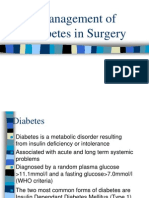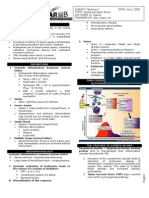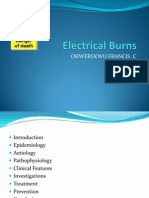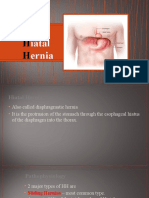Fat Embolism
Fat Embolism
Uploaded by
Suhanthi ManiCopyright:
Available Formats
Fat Embolism
Fat Embolism
Uploaded by
Suhanthi ManiOriginal Description:
Copyright
Available Formats
Share this document
Did you find this document useful?
Is this content inappropriate?
Copyright:
Available Formats
Fat Embolism
Fat Embolism
Uploaded by
Suhanthi ManiCopyright:
Available Formats
By
Dr Nethiya Vengataraman
Fat Embolism Syndrome
Fat embolism can occur due to the
migration of fat particles from the bone
marrow at the time of trauma or during
reaming of the intramedullary canal. This
causes the release of inflammatory
mediators ,with endothelial lung damage
and hypoxemia.
First diagnosed in 1873 by Dr Von Bergmann
Published in 1879 Fenger and Salisbury.
Fat Embolism:
Traumatic fat embolism occurs in up to 90% of
individuals with severe skeletal injuries, but < 10% of
such patients have any clinical symptoms / signs
Fat Embolism Syndrome:
FE with clinical manifestation .
Incidence: 1-3% femur #, 5-10% if bilateral or multiple.
Mortality: 5-15%
Clinical diagnosis :No specific laboratory test is
diagnostic
Mostly associated with long bone/pelvic #s, and more
frequent in closed fractures.
Onset is 24-72 hours from initial insult
A high index of suspicion is needed for diagnosis is to
be made.
An asymptomatic latent period - 12-48 hours.
The fulminant form presents as acute cor pulmonale,
respiratory failure, - death within a few hours of injury.
Mechanical and biochemical Theory
1. Two theories about fat embolism exist. First, the mechanical theory states
that large fat droplets are released into the venous system. These droplets are
deposited in the pulmonary capillary beds and travel through arteriovenous
shunts
to the brain. Micro vascular lodging of droplets produces local ischemia and
inflammation, with concomitant release of inflammatory mediators, platelet
aggregation, and vasoactive amines.
2. Second, the biochemical theory states that hormonal changes caused by
trauma and/or sepsis induce systemic release of free fatty acids as chylomicrons.
Acute-phase reactants, such as C-reactive proteins, cause chylomicrons to coalesce
and create the physiologic reactions described above. The biochemical theory
helps explain nontraumatic forms of fat embolism syndrome.
[1]
The biochemical theory
Circulating FFAs -directly toxic to Pneumocytes / capillary
Endothelium in the lung - interstitial hemorrhage, edema
& chemical pneumonitis.
Coexisting shock, hypovolemia and sepsis - reduce liver
flow exacerbate the toxic effects of FFAs.
H/E stain lung
- blood vessel with
fibrinoid material and
-optical empty space -lipid
dissolved during the
staining process.
TRAUMA
Hypoxemia
Neurological
abnormalities
Petechial
rash
Dyspnea,
Tachypnea
Hypoxemia PaO2 < 60 mm Hg
Clinically Tachpnea, Dyspnea, Hypoxia, rales, pleural
friction rub & ARDS.
High spiking temperatures.
Hypoxemia - ventilation-perfusion mismatch &
intrapulmonary shunting. Acute cor pulmonale -
respiratory distress, hypoxemia, hypotension and
elevated CVP.
of pts require mechanical ventilation
CXR normal early on - later may show snowstorm
pattern- diffuse bilateral infiltrates
CT chest: ground glass opacification with interlobular
septal thickening
CNS signs usually occur after respiratory symptoms -
nonspecific - features of diffuse encephalopathy
Acute confusion, stupor, coma, rigidity, or convulsions
- Transient and reversible in most cases
CT Head: general edema nonspecific
MRI brain: Low density on T1 & High intensity T2
signal - correlates to degree of impairment
Reddish-brown non-palpable Petechial rash - upper
anterior body, chest, neck, upper arm, axilla, shoulder,
oral mucous membranes and conjunctivae in 20 - 50%
patients.
Pathognomonic, however, it appears late and
disappears within hours.
Results from occlusion of dermal capillaries by fat
globules - extravasations of RBC
Retinopathy (exudates, cotton wool spots,
hemorrhage)
Lipiduria(fat globulin in the urine)
Fever
DIC
Myocardial depression (R heart strain)
Thrombocytopenia
Anemia, Decreased Hematocrit
Hypocalcemia
Gurds criteria
Most commonly used
1 major, plus 4 minor
The most effective prophylactic measure - operative
reduction/rigid fixation of long bone fractures as soon
as possible. Higher incidence (5 fold) when fixation
delayed greater than 24 hours.
Supportive care includes maintenance of adequate
oxygenation and ventilation, stable hemodynamics,
blood products as clinically indicated, hydration,
prophylaxis of DVT and stress-related GI bleeding.
Continuous pulse oximetry monitoring - at-risk
patients ( those patients with long bone fractures) -
detecting desaturations early.
Consultations recommended include orthopedists,
neurologists/ neurosurgeons, trauma care specialists,
critical care specialists, pulmonologists,
hematologists, and nutritionists.
Albumin has been recommended - not only restores
blood volume / binds fatty acids - may decrease the
extent of lung injury.
High dose corticosteroids have been effective in
preventing development of FES in several trials, but
controversy on this issue still persists.
Heparin has also been proposed as it activates lipase,
but no evidence exists for its use in FES.
DURATION OF FES
Difficult to predict FES is frequently subclinical or
overshadowed by other illnesses or injuries.
Increased alveolar-to-arterial oxygen gradient and
neurologic deficits, including coma, may last days or
weeks.
SEQUELAE
As in ARDS, pulmonary sequelae usually resolve
almost completely within 1 year.
Residual subclinical diffusion capacity deficits may
exist.
Residual neurologic deficits may range from
nonexistent to subtle personality changes to memory
and cognitive dysfunction to long-term focal deficits.
SUMMARY FES
Clinical diagnosis so high index of suspicion.
Most effective management is prevention with rigid
fixation of fractures within 24 hours
When developed management is supportive.
You might also like
- FREE 2022 ACLS Study Guide - ACLS Made Easy! PDFDocument18 pagesFREE 2022 ACLS Study Guide - ACLS Made Easy! PDFkumar23100% (2)
- Michigan Alcohol Screening Test (MAST)Document2 pagesMichigan Alcohol Screening Test (MAST)Petya KostadinovaNo ratings yet
- Spinal Cord InjuryDocument28 pagesSpinal Cord InjurydidiNo ratings yet
- Fat Embolism SyndromeDocument19 pagesFat Embolism SyndromeFaizah AlmuhsinNo ratings yet
- Transient Ischemic Attack: - Time Based Definition: (Old Definition) Harrisons Principle of Medicine 19 EditionDocument14 pagesTransient Ischemic Attack: - Time Based Definition: (Old Definition) Harrisons Principle of Medicine 19 EditionHermie Alexander SiaNo ratings yet
- Pagets DiseaseDocument62 pagesPagets DiseaseKush PathakNo ratings yet
- Raynaud's Disease - JERAIZADocument23 pagesRaynaud's Disease - JERAIZAmaU439No ratings yet
- AppendectomyDocument51 pagesAppendectomymoqtadirNo ratings yet
- POLYMYOLITISDocument4 pagesPOLYMYOLITISAlexa Lexington Rae ZagadoNo ratings yet
- Compartment SyndromeDocument23 pagesCompartment SyndromeTufikifa N. NakaleNo ratings yet
- Compartment SyndromeDocument21 pagesCompartment SyndromeMiztaloges86100% (1)
- Fat Embolism SyndromeDocument26 pagesFat Embolism SyndromeAzni MokhtarNo ratings yet
- Myasthenia GravisDocument43 pagesMyasthenia GravisNgurah Arya PradnyantaraNo ratings yet
- Blunt Trauma AbdomenDocument41 pagesBlunt Trauma AbdomenSanthanu SukumaranNo ratings yet
- Management of Diabetes Patients in SurgeryDocument28 pagesManagement of Diabetes Patients in Surgerylow_sernNo ratings yet
- Compartment Syndrome AndreDocument40 pagesCompartment Syndrome AndreOlivia Christy KaihatuNo ratings yet
- The Physiology of ShockDocument12 pagesThe Physiology of Shockb3djo_76No ratings yet
- What Is AIDS?Document7 pagesWhat Is AIDS?Bhavya PNo ratings yet
- Head InjuryDocument27 pagesHead InjuryAmanda100% (1)
- HydrocephalusDocument33 pagesHydrocephalusrajan kumar100% (2)
- Transient Ischemic AttackDocument19 pagesTransient Ischemic Attackjoshua sondakhNo ratings yet
- Advanced Life SupportDocument65 pagesAdvanced Life SupportPrasad Narangoda100% (1)
- Guillain Barre Syndrome (GBS) ImanDocument26 pagesGuillain Barre Syndrome (GBS) ImanTowardsLight100% (5)
- 10 EncephalopathyDocument18 pages10 EncephalopathyAbdullah ShiddiqNo ratings yet
- Head InjuryDocument7 pagesHead InjurySariiNo ratings yet
- CraniotomyDocument10 pagesCraniotomyUzma KhanNo ratings yet
- Supracondylar Humerus FractureDocument13 pagesSupracondylar Humerus FracturedhapitstinNo ratings yet
- Sepsis and Septic ShockDocument4 pagesSepsis and Septic Shocksarguss14100% (4)
- Acute AppendicitisDocument17 pagesAcute AppendicitisMukhtar Khan0% (1)
- Precautions With Diabetic Patients Undergoing SurgeryDocument6 pagesPrecautions With Diabetic Patients Undergoing SurgeryErvin Kyle OsmeñaNo ratings yet
- Intracerebral Hemorrhage - Classification, Clinical Symptoms, DiagnosticsDocument27 pagesIntracerebral Hemorrhage - Classification, Clinical Symptoms, DiagnosticsJoisy AloorNo ratings yet
- Electrical BurnsDocument28 pagesElectrical BurnsFrancis OkwerekwuNo ratings yet
- Bites & Stings PressDocument4 pagesBites & Stings PressNikki CoplandNo ratings yet
- Neurogenic ShockDocument3 pagesNeurogenic ShockGlaizalyn Fabella TagoonNo ratings yet
- Status EpilepticusDocument28 pagesStatus EpilepticusDaniel AlfredNo ratings yet
- OMCDocument37 pagesOMCyurie_ameliaNo ratings yet
- OsteomyelitisDocument8 pagesOsteomyelitisMargarette Lopez0% (1)
- Laparoscopic CholecystectomyDocument41 pagesLaparoscopic CholecystectomyLim MelaniNo ratings yet
- THORACOTOMYDocument3 pagesTHORACOTOMYConnie May Fernando Evangelio100% (1)
- Hyperosmolar Hyperglycemic State (HHS)Document21 pagesHyperosmolar Hyperglycemic State (HHS)Malueth Angui100% (1)
- Spinal Cord InjuryDocument35 pagesSpinal Cord InjuryRhOmadona GenzoneNo ratings yet
- Epilepsy NotesDocument6 pagesEpilepsy NotesPrarthana Thiagarajan100% (1)
- Cerebellar Ataxia Pathophysiology and RehabilitationDocument23 pagesCerebellar Ataxia Pathophysiology and RehabilitationMikail AtiyehNo ratings yet
- Mini-Case Presentation: Mild Head InjuryDocument16 pagesMini-Case Presentation: Mild Head InjuryMarianne OblefiasNo ratings yet
- Septic Shock: Supervisor: DR Ali Haedar, Sp. EM FAHA Dinisa Novaurahmah Nanin Aprilia PutriDocument42 pagesSeptic Shock: Supervisor: DR Ali Haedar, Sp. EM FAHA Dinisa Novaurahmah Nanin Aprilia PutriMutia Larasati Albar0% (1)
- Bites & StingsDocument78 pagesBites & StingsleemurrieNo ratings yet
- ESCHAROTOMYDocument31 pagesESCHAROTOMYSusan Rose FuertesNo ratings yet
- Hiatal Hernia AchalasiaDocument22 pagesHiatal Hernia AchalasiaDhen MarcNo ratings yet
- Head Injury Final TurelDocument52 pagesHead Injury Final TurelkarahmanNo ratings yet
- Hyperglycemic Hyperosmolar StateDocument17 pagesHyperglycemic Hyperosmolar StateAqila Mumtaz50% (2)
- OsteomyelitisDocument47 pagesOsteomyelitisArmand Al HaraaniNo ratings yet
- Febrile SeizureDocument25 pagesFebrile SeizureNagham HaddaraNo ratings yet
- Case Presentation About Spinal Shock SyndromeDocument56 pagesCase Presentation About Spinal Shock SyndromeAstral_edge010100% (1)
- OsteomalaciaDocument8 pagesOsteomalaciaRudhira KatragaddaNo ratings yet
- Rheumatoid HandDocument67 pagesRheumatoid HandSayantika DharNo ratings yet
- Spinal Cord InjuryDocument27 pagesSpinal Cord InjuryHanis Malek100% (2)
- Slide Ortho Tibia and FibulaDocument25 pagesSlide Ortho Tibia and Fibulaleonard0% (1)
- Acute Stroke Management by Carlos L Chua PDFDocument61 pagesAcute Stroke Management by Carlos L Chua PDFHynne Jhea EchavezNo ratings yet
- Negative Pressure Wound TherapyDocument21 pagesNegative Pressure Wound TherapyKathy Real Vills100% (2)
- A Simple Guide to Abdominal Aortic Aneurysm, Diagnosis, Treatment and Related ConditionsFrom EverandA Simple Guide to Abdominal Aortic Aneurysm, Diagnosis, Treatment and Related ConditionsNo ratings yet
- Dr.E.Kaizar EnnisDocument29 pagesDr.E.Kaizar EnnisKaizar EnnisNo ratings yet
- HTTP Anestit - Unipa.it Gta Fat EmbolismDocument3 pagesHTTP Anestit - Unipa.it Gta Fat EmbolismbloybloyNo ratings yet
- Senarai Peserta Big Science CompetitionDocument1 pageSenarai Peserta Big Science CompetitionSuhanthi ManiNo ratings yet
- Daily English Language Lesson Plan: MissashDocument5 pagesDaily English Language Lesson Plan: MissashSuhanthi ManiNo ratings yet
- A) Match The Picture With The Correct Words. 1: Living RoomDocument2 pagesA) Match The Picture With The Correct Words. 1: Living RoomSuhanthi ManiNo ratings yet
- AdventureDocument1 pageAdventureSuhanthi ManiNo ratings yet
- Summative Test 4Document7 pagesSummative Test 4Suhanthi Mani100% (2)
- Kona's Expresso Coffee Annual Cost of Goods: New York Chicago Denver SeattleDocument5 pagesKona's Expresso Coffee Annual Cost of Goods: New York Chicago Denver SeattleSuhanthi ManiNo ratings yet
- Saravanan BaskaranDocument7 pagesSaravanan BaskaranSuhanthi ManiNo ratings yet
- Chapter 4 - Measurement: Every Question Is Followed by Four Options A, B, C and D. Choose The Correct AnswerDocument15 pagesChapter 4 - Measurement: Every Question Is Followed by Four Options A, B, C and D. Choose The Correct AnswerSuhanthi ManiNo ratings yet
- Summative Test 3: Section A Time: 30 MinutesDocument8 pagesSummative Test 3: Section A Time: 30 MinutesSuhanthi ManiNo ratings yet
- Answers: Section ADocument2 pagesAnswers: Section ASuhanthi ManiNo ratings yet
- Chapter 1 - Living Things Have Basic NeedsDocument13 pagesChapter 1 - Living Things Have Basic NeedsSuhanthi ManiNo ratings yet
- Experiment 5 PDFDocument1 pageExperiment 5 PDFSuhanthi ManiNo ratings yet
- Experiment 12 PDFDocument2 pagesExperiment 12 PDFSuhanthi ManiNo ratings yet
- Experiment 13Document2 pagesExperiment 13Suhanthi ManiNo ratings yet
- Experiment 10 PDFDocument2 pagesExperiment 10 PDFSuhanthi ManiNo ratings yet
- Nursing Department: Bicol University Tabaco Campus Tabaco CityDocument3 pagesNursing Department: Bicol University Tabaco Campus Tabaco CityCelline Isabelle ReyesNo ratings yet
- (FREE PDF Sample) Fish S Clinical Psychopathology Signs and Symptoms in Psychiatry 4th Ed 4th Edition Patricia Casey EbooksDocument62 pages(FREE PDF Sample) Fish S Clinical Psychopathology Signs and Symptoms in Psychiatry 4th Ed 4th Edition Patricia Casey Ebookswqeqwmuddi100% (6)
- DR - Kim File 3Document70 pagesDR - Kim File 3Tanveer HamidNo ratings yet
- Infection Control in Dental RadiologyDocument41 pagesInfection Control in Dental RadiologyDrShweta Saini0% (1)
- TOACS OSCE Exam For IMM & Part IIDocument71 pagesTOACS OSCE Exam For IMM & Part IIFurqan MirzaNo ratings yet
- Surgical Emergencies in Clinical Practice (2013) (UnitedVRG)Document225 pagesSurgical Emergencies in Clinical Practice (2013) (UnitedVRG)ngwinda90No ratings yet
- GDM Nice GuidelinesDocument56 pagesGDM Nice GuidelinesArfa NageenNo ratings yet
- Surgicalsite InfectionDocument27 pagesSurgicalsite Infectionmsat72No ratings yet
- Maham PrsentationDocument28 pagesMaham PrsentationAlbern ArifNo ratings yet
- Mental Oromo 2 05 - A11yDocument6 pagesMental Oromo 2 05 - A11ymilkiihambisaNo ratings yet
- Curs Epidemiologie Parte NgeneralaDocument142 pagesCurs Epidemiologie Parte NgeneralaDragomir P. AdrianNo ratings yet
- SIADHDocument39 pagesSIADHMohammed Sayed AlmattryNo ratings yet
- GI Pharmacology QuestionsDocument2 pagesGI Pharmacology Questionsnassaglobal100% (1)
- Mitomycin C in OphthalmologyDocument3 pagesMitomycin C in OphthalmologyHisar DanielNo ratings yet
- Pacemaker ImplantationDocument17 pagesPacemaker ImplantationKaku ManishaNo ratings yet
- Pancreatic Pseudocyst 2Document37 pagesPancreatic Pseudocyst 2AzharUlHassanQureshi100% (1)
- HYDROCELE Case PresentationDocument27 pagesHYDROCELE Case PresentationeshasakriNo ratings yet
- NHS Lanarkshire Palliative Care GuidelinesDocument82 pagesNHS Lanarkshire Palliative Care GuidelinesAndi WiraNo ratings yet
- FISH S NOTES Disorder of PerceptionDocument15 pagesFISH S NOTES Disorder of Perceptionbrainlybliss7100% (1)
- Cholecystitis Nursing Care PlanDocument4 pagesCholecystitis Nursing Care PlanMDCITY83% (6)
- Water Balance and Regulation of OsmolalityDocument35 pagesWater Balance and Regulation of OsmolalityMaria InolynNo ratings yet
- International Classification of Diseases - 10 Edition: Presentation By-Saloni Punya Akanksha FarheenDocument16 pagesInternational Classification of Diseases - 10 Edition: Presentation By-Saloni Punya Akanksha FarheenAakanksha VermaNo ratings yet
- OTC Advisor - Fever, Cough, Cold, and Allergy FINAL PDFDocument33 pagesOTC Advisor - Fever, Cough, Cold, and Allergy FINAL PDFmorsi0% (1)
- Edmonton Symptom Assessment SystemDocument2 pagesEdmonton Symptom Assessment SystemVanita NoronhaNo ratings yet
- Draft Part 1. Choose The Best Single Answer (BSA) by Encircling Its Corresponding LetterDocument11 pagesDraft Part 1. Choose The Best Single Answer (BSA) by Encircling Its Corresponding LetterKhadar mohamedNo ratings yet
- NCP Draft - Ectopic PregnancyDocument7 pagesNCP Draft - Ectopic PregnancyD CNo ratings yet
- Dipiro - HipertensiDocument20 pagesDipiro - Hipertensidutainspirasi.vickyedr21No ratings yet
- Anatomi Dan Fisiologi KorneaDocument133 pagesAnatomi Dan Fisiologi KorneaAriyanie NurtaniaNo ratings yet








































































































